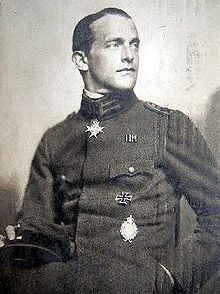Carl Menckhoff

Carl Menckhoff (born April 14, 1883 in Herford , † January 11, 1948 in Basel ) was a German fighter pilot in World War I and a knight of the order Pour le Mérite .
Life
Menckhoff was born the son of a factory owner and learned the trade after high school. In 1903 he was drafted into the military, but after a short time he was released because of an appendicitis. When the war broke out in 1914, the now 31-year-old Menckhoff reported again for the military and went into the field with the Leipzig infantry regiment "King Georg" (7th Royal Saxon) No. 106 . In 1914 he was awarded the Iron Cross of both classes before returning home wounded in December.
In order to shorten the period of his inactivity, the convalescent volunteered for the air force in February 1915 . After completing his training, he initially served as an observer on the Eastern Front before he was assigned to the Warsaw Fighter Aviation School in autumn 1916. At the beginning of 1917 Menckhoff came to Flanders for Jagdstaffel 3 and scored his first kill on an Albatros D.III on April 5, 1917 . When he tried on September 23, 1917 to help Werner Voss in his fatal final aerial combat, he was already an experienced fighter pilot with twelve aerial victories, but was shot down by Arthur Rhys-Davids of the 56th Sqn RFC, like Voss . Menckhoff survived the crash, but was shot down again five days later by the airmen of the 56th Sqn. On December 28, 1917, he defeated the Canadian fighter pilot Cpt, who was also successful with ten kills. Alfred Edwin McKay . In total, he achieved 20 victories in his time at the Jasta 3.
On February 11, 1918, Menckhoff, who had meanwhile been promoted to lieutenant in the reserve, took over the newly formed Saxon Jasta 72 as squadron leader, with whom he was to achieve another 19 aerial victories. On April 23, 1918, after his 25th victory in the air, he was awarded the Order of Pour le Mérite. On July 25, 1918 he was at Château-Thierry by Lt. Walter Avery, an American aviator with the 95th Pursuit Squadron, was forced to land in his Fokker D.VII and was taken prisoner of war. In August 1919 he managed to escape from the Montoire prison camp . He made his way to Switzerland , where he settled down and became a successful businessman.
The house belonging to his family at Herford Parkstrasse 6, in which he spent part of his youth, was initially confiscated after 1945 as the British general seat (Herford was a garrison town and the headquarters of the British occupying forces). Today the building houses the church music college of the Evangelical Church of Westphalia .
literature
- Jürgen Brinkmann: The knights of the order Pour le merite 1914-1918. Th.Schäfer Druckerei Hannover, Bückeburg 1982, DNB 870511343 .
- Karl-Friedrich Hildebrand, Christian Zweng: The knights of the order Pour le Mérite of the First World War. Volume 2: HO. Biblio Verlag, Bissendorf 2003, ISBN 3-7648-2516-2 , p. 435.
- Walter Zuerl: Pour le merite-Flieger. Luftfahrtverlag Axel Zuerl, 1987, ISBN 3-934596-15-0 .
See also
Web links
| personal data | |
|---|---|
| SURNAME | Menckhoff, Carl |
| ALTERNATIVE NAMES | Menckhoff, Karl |
| BRIEF DESCRIPTION | German fighter pilot in the First World War |
| DATE OF BIRTH | April 14, 1883 |
| PLACE OF BIRTH | Herford |
| DATE OF DEATH | January 11, 1948 |
| Place of death | Basel |